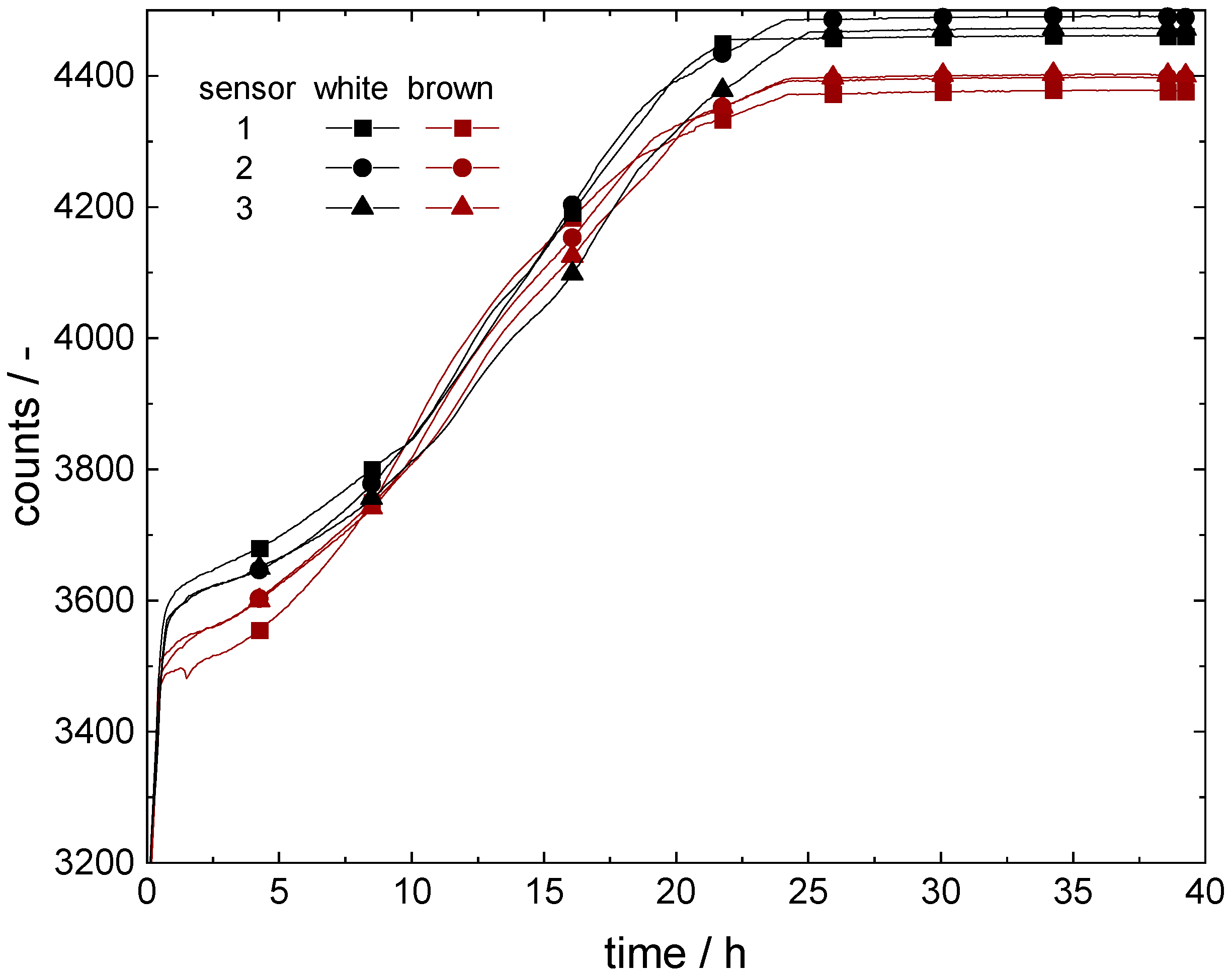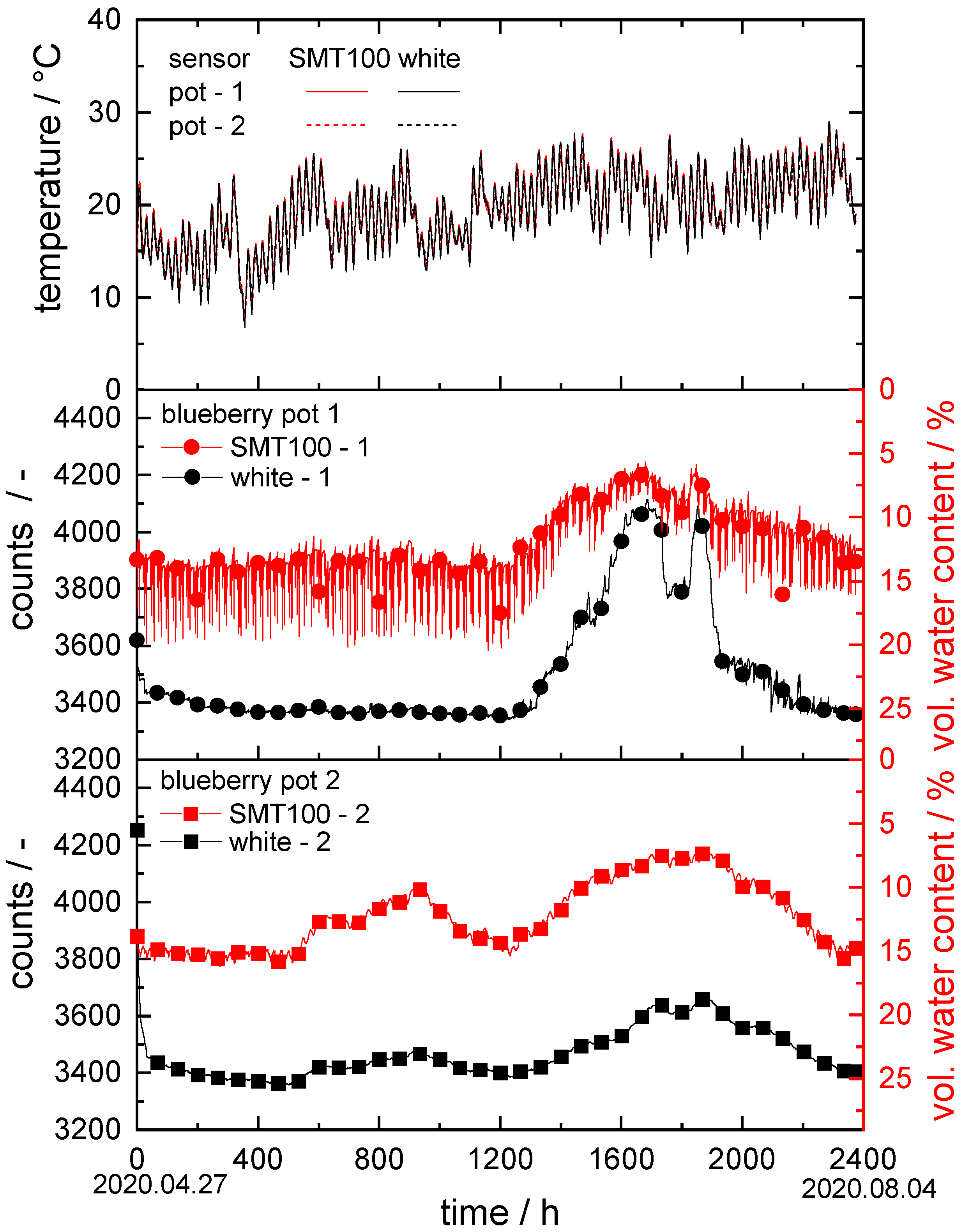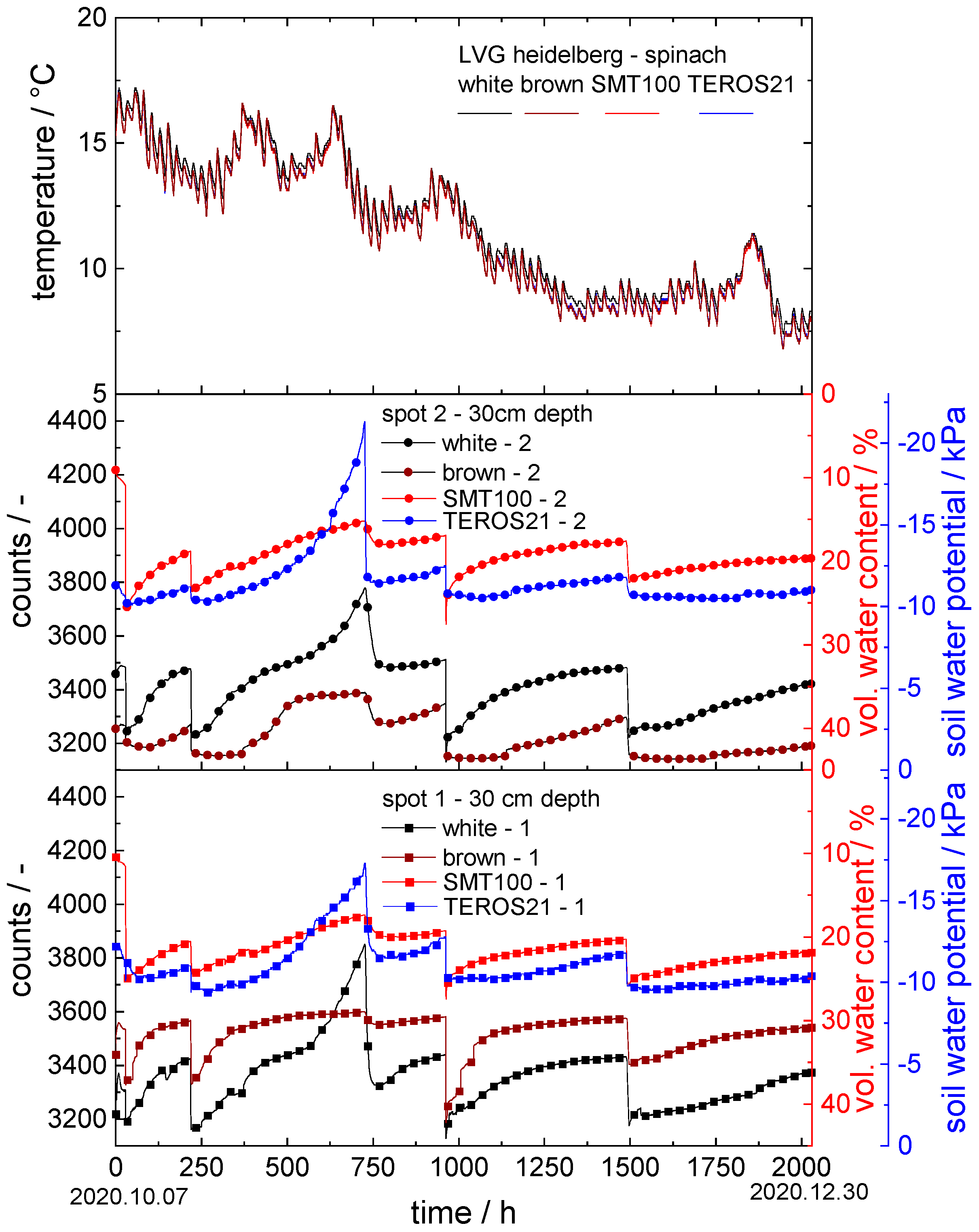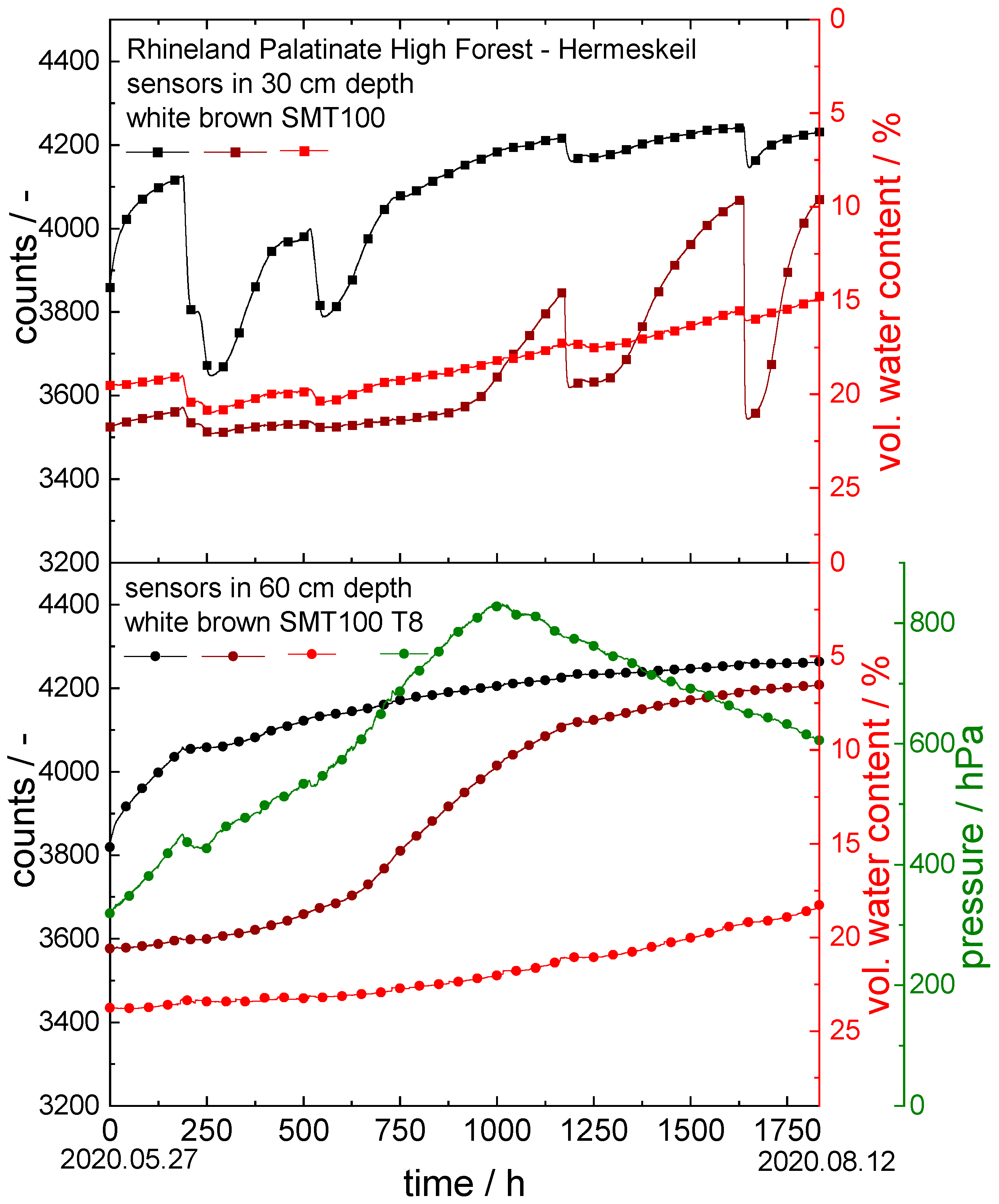Robust Soil Water Potential Sensor to Optimize Irrigation in Agriculture
Abstract
:1. Introduction
2. Materials and Methods
2.1. Raw Material
2.2. Ceramic and Sensor Characterization
3. Results
3.1. Ceramic and Sensor Properties
3.2. Air Drying Experiments: Laboratory
3.3. Soil Moisture Measurement Experiments
3.3.1. Hegehof
3.3.2. Erlenhof
3.3.3. LVG
- Tomato research field:
- Spinach research field:
3.3.4. Rhineland Palatinate High Forest: Hermeskeil
4. Discussion
5. Conclusions
Author Contributions
Funding
Institutional Review Board Statement
Informed Consent Statement
Data Availability Statement
Acknowledgments
Conflicts of Interest
References
- Voosen, P. Global temperatures in 2020 tied record highs. Science 2021, 37, 334–336. [Google Scholar] [CrossRef] [PubMed]
- Fischer, G.; Tubiello, F.N.; van Velthuizen, H.; Wiberg, D.A. Climate change impacts on irrigation water requirements: Effects of mitigation, 1990–2080. Technol. Forecast. Soc. Chang. 2007, 74, 1083–1107. [Google Scholar] [CrossRef] [Green Version]
- Siebert, S.; Döll, P. Quantifying blue and green virtual water contents in global crop production as well as potential production losses without irrigation. J. Hydrol. 2010, 384, 198–217. [Google Scholar] [CrossRef]
- Hamdy, A.; Ragab, R.; Scarascia-Mugnozza, E. Coping with water scarcity: Water saving and increasing water productivity. Irrig. Drain. 2003, 52, 3–20. [Google Scholar] [CrossRef]
- Bittelli, M. Measuring soil water potential forwater management in agriculture: A review. Sustainability 2010, 2, 1226–1251. [Google Scholar] [CrossRef] [Green Version]
- McDermid, S.S.; Mahmood, R.; Hayes, M.J.; Bell, J.E.; Lieberman, Z. Minimizing trade-offs for sustainable irrigation. Nat. Geosci. 2021, 14, 706–709. [Google Scholar] [CrossRef]
- Lischeid, G.; Merz, C.; Schindler, U.; Schulz, R.; Steidl, J.; Tauschke, R. Quantifying process heterogeneity: Signal propagation in hydrological systems. Assembly 2009, 11, 6701. [Google Scholar]
- Hardie, M. Review of novel and emerging proximal soil moisture sensors for use in agriculture. Sensors 2020, 20, 6934. [Google Scholar] [CrossRef]
- Degré, A.; van der Ploeg, M.J.; Caldwell, T.; Gooren, H.P.A. Comparison of Soil Water Potential Sensors: A Drying Experiment. Vadose Zone J. 2017, 16, 1–8. [Google Scholar] [CrossRef]
- Jackisch, C.; Germer, K.; Graeff, T.; Andrä, I.; Schulz, K.; Schiedung, M.; Haller-Jans, J.; Schneider, J.; Jaquemotte, J.; Helmer, P.; et al. Soil moisture and matric potential-an open field comparison of sensor systems. Earth Syst. Sci. Data 2020, 12, 683–697. [Google Scholar] [CrossRef] [Green Version]
- Novick, K.A.; Ficklin, D.L.; Baldocchi, D.; Davis, K.J.; Ghezzehei, T.A.; Konings, A.G.; MacBean, N.; Raoult, N.; Scott, R.L.; Shi, Y.; et al. Confronting the water potential information gap. Nat. Geosci. 2022, 15, 158–164. [Google Scholar] [CrossRef] [PubMed]
- Muñoz-Carpena, R. Field Devices For Monitoring Soil Water Content. Edis 2004, 2004, 1–16. [Google Scholar] [CrossRef]
- Whalley, W.R.; Watts, C.W.; Hilhorst, M.A.; Bird, N.R.A.; Balendonck, J.; Longstaff, D.J. The design of porous material sensors to measure the matric potential of water in soil. Eur. J. Soil Sci. 2001, 52, 511–519. [Google Scholar] [CrossRef]
- Whalley, W.R.; Clark, L.J.; Take, W.A.; Bird, N.R.A.; Leech, P.K.; Cope, R.E.; Watts, C.W. A porous-matrix sensor to measure the matric potential of soil water in the field. Eur. J. Soil Sci. 2007, 58, 18–25. [Google Scholar] [CrossRef]
- Whalley, W.R.; Lock, G.; Jenkins, M.; Peloe, T.; Burek, K.; Balendonck, J.; Take, W.A.; Tuzel, İ.H.; Tuzel, Y. Measurement of Low Matric Potentials with Porous Matrix Sensors and Water-Filled Tensiometers. Soil Sci. Soc. Am. J. 2009, 73, 1796–1803. [Google Scholar] [CrossRef]
- Or, D.; Wraith, J.M. A new soil matric potential sensor based on time domain reflectometry. Water Resour. Res. 1999, 35, 3399–3407. [Google Scholar] [CrossRef]
- Persson, M.; Wraith, J.M.; Dahlin, T. A Small-Scale Matric Potential Sensor Based on Time Domain Reflectometry. Soil Sci. Soc. Am. J. 2006, 70, 533–536. [Google Scholar] [CrossRef] [Green Version]
- Xin, X.L.; Xu, F.A.; Zhang, J.B.; Xu, M.X. A New Resistance Sensor for Monitoring Soil Matric Potential. Soil Sci. Soc. Am. J. 2007, 71, 866–871. [Google Scholar] [CrossRef]
- da Mota, W.N.; Evangelista, A.W.P.; Maia, L.J.Q.; Correchel, V.; Alves, J.; Varrone, L.F.R.; Gitirana, G.d.F.N. Development of a heat pulse sensor for measuring matric suction on soilless substrates. Comput. Electron. Agric. 2021, 185, 106119. [Google Scholar] [CrossRef]
- Chen, C.; Yan, X.; Xu, Q.; Yu, S.; Ma, Y.; Cheng, X.; Wang, Z.; Cheng, Q. A novel frequency domain impedance sensor with a perforated cylinder coaxial design for in-situ measuring soil matric potential. Sensors 2019, 19, 2626. [Google Scholar] [CrossRef] [Green Version]
- Carvalhaes-Dias, P.; Morais, F.J.O.; Duarte, L.F.C.; Cabot, A.; Dias, J.A.S. Autonomous soilwater content sensors based on bipolar transistors encapsulated in porous ceramic blocks. Appl. Sci. 2019, 9, 1211. [Google Scholar] [CrossRef] [Green Version]
- Chen, Y.; Tian, Y.; Wang, X.; Dong, L. Miniaturized Soil Sensor for Continuous, In-Situ Monitoring of Soil Water Potential. In Proceedings of the 2019 20th International Conference on Solid-State Sensors, Actuators and Microsystems & Eurosensors XXXIII (TRANSDUCERS & EUROSENSORS XXXIII), Berlin, Germany, 23–27 June 2019; pp. 2025–2028. [Google Scholar] [CrossRef]
- Goodchild, M.S.; Jenkins, M.D.; Whalley, W.R.; Watts, C.W. A novel dielectric tensiometer enabling precision PID-based irrigation control of polytunnel-grown strawberries in coir. Biosyst. Eng. 2018, 165, 70–76. [Google Scholar] [CrossRef]
- Lungal, M.; Si, B.C. Coiled Time Domain Reflectometry Matric Potential Sensor. Soil Sci. Soc. Am. J. 2008, 72, 1422–1424. [Google Scholar] [CrossRef]
- Matile, L.; Berger, R.; Wächter, D.; Krebs, R. Characterization of a new heat dissipation matric potential sensor. Sensors 2013, 13, 1137–1145. [Google Scholar] [CrossRef] [Green Version]
- METER Group AG TEROS 21_Soil Water Potential Sensor_METER Environment. Available online: https://www.metergroup.com/environment/products/teros-21/ (accessed on 5 March 2022).
- MMM Tech Support GmbH & Co. KG Irrometer Company Watermark Sensor—MMM—Mosler Tech Support. Available online: https://www.mmm-tech.de/de/watermark/wms#top (accessed on 5 March 2022).
- Delta-T Devices Ltd. EQ3 Equitensiometer—Soil Water Potential. Available online: https://www.delta-t.co.uk/product/eq3/ (accessed on 5 March 2022).
- EcoTech Umwelt Meßsysteme GmbH EcoTech Umwelt Meßsysteme GmbH Tensiomark. Available online: https://www.ecotech.de/produkt/tensiomark (accessed on 5 March 2022).
- Bakker, G.; van der Ploeg, M.J.; de Rooij, G.H.; Hoogendam, C.W.; Gooren, H.P.A.; Huiskes, C.; Koopal, L.K.; Kruidhof, H. New Polymer Tensiometers: Measuring Matric Pressures Down to the Wilting Point. Vadose Zone J. 2007, 6, 196–202. [Google Scholar] [CrossRef] [Green Version]
- Umwelt-Geräte-Technik GmbH UGT Umwelt-Geräte-Technik Watermark. Available online: https://www.ugt-online.de/en/products/soil-science/tensiometers/watermark (accessed on 5 March 2022).
- Van Der Ploeg, M.J.; Gooren, H.P.A.; Bakker, G.; Hoogendam, C.W.; Huiskes, C.; Koopal, L.K.; Kruidhof, H.; De Rooij, G.H. Polymer tensiometers with ceramic cones: Direct observations of matric pressures in drying soils. Hydrol. Earth Syst. Sci. 2010, 14, 1787–1799. [Google Scholar] [CrossRef] [Green Version]
- Hübner, C.; Kaatze, U. Electromagnetic Moisture Measurement. Principles and Applications; Universitätsverlag Göttingen: Göttingen, Germany, 2016; ISBN 978-3-86395-260-0. [Google Scholar]
- Menne, D.; Hubner, C.; Trebbels, D.; Willenbacher, N. A Robust Soil Water Potential Sensor with High Sensitivity and Broad Measuring Range. In Proceedings of the 2021 13th International Conference on Electromagnetic Wave Interaction with Water and Moist Substances (ISEMA), Kiel, Germany, 26–30 July 2021; pp. 1–7. [Google Scholar] [CrossRef]
- Dittmann, J.; Maurath, J.; Bitsch, B.; Willenbacher, N. Highly Porous Materials with Unique Mechanical Properties from Smart Capillary Suspensions. Adv. Mater. 2016, 28, 1689–1696. [Google Scholar] [CrossRef]
- Dittmann, J.; Willenbacher, N. Micro structural investigations and mechanical properties of macro porous ceramic materials from capillary suspensions. J. Am. Ceram. Soc. 2014, 97, 3787–3792. [Google Scholar] [CrossRef]
- Maurath, J.; Bitsch, B.; Schwegler, Y.; Willenbacher, N. Influence of particle shape on the rheological behavior of three-phase non-brownian suspensions. Colloids Surf. A Physicochem. Eng. Asp. 2016, 497, 316–326. [Google Scholar] [CrossRef]
- Dittmann, J.; Koos, E.; Willenbacher, N. Ceramic capillary suspensions: Novel processing route for macroporous ceramic materials. J. Am. Ceram. Soc. 2013, 96, 391–397. [Google Scholar] [CrossRef]
- Schlaeger, S.; Huebner, C.; Becker, R. Simple soil moisture probe for low-cost measurement applications. In Proceedings of the 6th Conference on Electromagnetic Wave Interaction with Water and Moist Substances, ISEMA 2005, Weimar, Germany, 29 May–1 June 2005; pp. 258–265. [Google Scholar]
- Pham, H.Q.; Fredlund, D.G.; Barbour, S.L. A study of hysteresis models for soil-water characteristic curves. Can. Geotech. J. 2005, 42, 1548–1568. [Google Scholar] [CrossRef]









| System Name | Manufacturer | Measuring Range | Approx. Price | Source |
|---|---|---|---|---|
| TEROS 21 (former MPS-6) | METER Group, Inc. (Pullman, WA, USA) (former Decagon Devices, Inc.) | 90 to ∞ hPa | 250 € | [26] |
| Watermark (granular matrix) | Irrometer Company, Inc. (Riverside, CA, USA) | 0 to 2000 hPa | 70 € | [27] |
| EQ3 Equitensiometer | Delta-T Devices Ltd. (Burwell, Cambridge, UK) | 0 to 10,000 hPa | 800 € | [28] |
| Tensiomark (0–7) | EcoTech Umwelt-Meßsysteme GmbH (Bonn, Germany) | 1 to 10,000,000 hPa | 650 € | [29] |
| Full Range (Polymer-) Tensiometer | Wageningen University (Wageningen, The Netherlands) | 0 to 15,000 hPa | 1000 € | [30,31,32] |
| Ceramic Type | Diameter/mm | Height/mm | x10,3/μm | x50,3/μm | x90,3/μm | εopen/% | σ/MPa |
|---|---|---|---|---|---|---|---|
| brown ceramic | 43.0 ± 0.2 | 5.0 ± 0.2 | 16 | 41 | 72 | 59 ± 3 | 12 ± 3 |
| white ceramic | 43.0 ± 0.2 | 5.0 ± 0.2 | 44 | 101 | 159 | 69 ± 3 | 6 ± 1 |
| TEROS 21 | 31.5 ± 0.5 | 2.9 ± 0.1 | 45 | 93 | 148 | 62 ± 2 | 6 ± 1 |
| Spot | White/Counts | TEROS 21/kPa | SMT100/% | Brown/Counts |
|---|---|---|---|---|
| 2 | 3484 ± 10 | 11.7 ± 0.5 | 16.5 ± 2.8 | 3292 ± 35 |
| 1 | 3406 ± 25 | 11.9 ± 0.6 | 16.5 ± 2.8 | 3567 ± 10 |
Publisher’s Note: MDPI stays neutral with regard to jurisdictional claims in published maps and institutional affiliations. |
© 2022 by the authors. Licensee MDPI, Basel, Switzerland. This article is an open access article distributed under the terms and conditions of the Creative Commons Attribution (CC BY) license (https://creativecommons.org/licenses/by/4.0/).
Share and Cite
Menne, D.; Hübner, C.; Trebbels, D.; Willenbacher, N. Robust Soil Water Potential Sensor to Optimize Irrigation in Agriculture. Sensors 2022, 22, 4465. https://doi.org/10.3390/s22124465
Menne D, Hübner C, Trebbels D, Willenbacher N. Robust Soil Water Potential Sensor to Optimize Irrigation in Agriculture. Sensors. 2022; 22(12):4465. https://doi.org/10.3390/s22124465
Chicago/Turabian StyleMenne, David, Christof Hübner, Dennis Trebbels, and Norbert Willenbacher. 2022. "Robust Soil Water Potential Sensor to Optimize Irrigation in Agriculture" Sensors 22, no. 12: 4465. https://doi.org/10.3390/s22124465
APA StyleMenne, D., Hübner, C., Trebbels, D., & Willenbacher, N. (2022). Robust Soil Water Potential Sensor to Optimize Irrigation in Agriculture. Sensors, 22(12), 4465. https://doi.org/10.3390/s22124465







